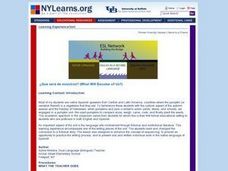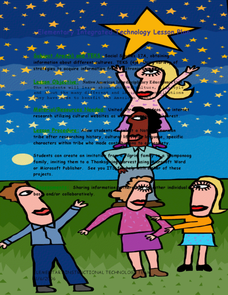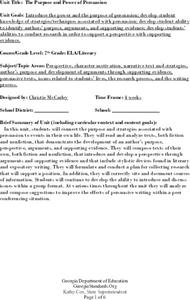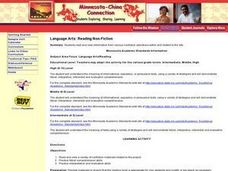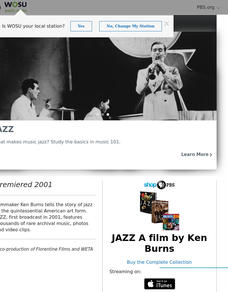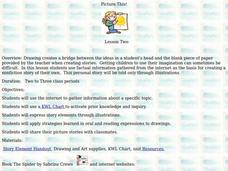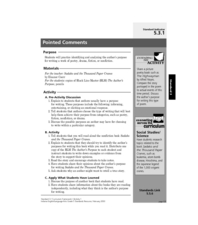Curated OER
Fact or Fantasy Writing
First graders see that some written text is for pleasure and enjoyment while some is for relaying information. They get to experience both types during the lesson. They brainstorm ideas for a story about a new kid in school to write about.
Curated OER
?Que ser de nosotros? (What Will Become of Us?)
Students discuss uses of a pumpkin. They fill out graphic organizers. Students listen as the teacher reads a story, and participate by repeating sounds the objects make as the story progresses. One student narrates the story while others...
Curated OER
Elaborating the Main Idea, Using Supporting Details
A desk is used as a visual analogy to construct the main idea and supporting details in a story. The top of the desk is the main idea, and each of the four legs provides supporting details. The legs of the desk provide support for the...
Curated OER
Native Americans
First graders explore the lifestyles of several North American tribes. They investigate about the homes, food, transportation, and daily living habits of each tribe. Pupils use a map to locate several Native American tribes in North...
Curated OER
Deduction
Young scholars investigate the linguistic devices used by writers to create meaning. In this writing lesson, students discover why writers write in different ways showing examples of different types of text. After reading each type young...
Curated OER
The Purpose and Power of Persuasion
Seventh graders are introduced to and discuss the power of persuasion. After reading text, they identify the author's purpose, perspective and argument. They write their own fiction and non-fiction texts and develop a perspective after...
Curated OER
Johnny Appleseed or John Chapman: Which Character is Your Favorite?
Students study the life of John Chapman and compare it with the fictional character, Johnny Appleseed. Students listen to books about Johnny Appleseed, and watch a video and PowerPoint if available. They make a KWL chart, make an online...
Curated OER
Language Arts: Reading Non-Fiction
Students read and view information sent from seven high school students who travel to China. The daily reports that they send back to the weblog section of the site should be of high interest to students in Minnesota.
Curated OER
Introducing Working Animals
Students identify ways humans and animals work together. In this animal welfare lesson, students read the text Hanni and Beth: Safe and Sound and define the term "working animals." Students investigate working animals by visiting various...
Curated OER
Analyzing Features of Consumer Text
Students evaluate consumer information. In this written communication lesson, students read nutrition facts from different foods and determine the foods that have the most healthful benefits.
Curated OER
Recognizing Text Features of Fiction, Poetry, and Drama
Students start reading the book The Sign of the Beaver and create a book mark glossary to define vocabulary for the book. In this reading lesson plan, students also respond to the text by completing a journal entry.
Dream of a Nation
Writing an Analytic Essay
After researching an issue introduced in Tyson Miller's Dream of a Nation: Inspiring Ideas for a Better America, writers develop an original thesis statement and craft an analytic essay using evidence collected in their research.
Digital Writing and Research Lab's – Lesson Plans
Teaching Close Reading through Short Composition/Revision
This activity may have writers evaluate short compositions, but their subjects are quite tall: great Americans. Pupils read one another's compositions and closely examine how specific phrases and diction contribute to shaping American...
Curated OER
What is a Biography?
Investigate biographies with your class. Compare autobiographies and biographies of Martin Luther King, Jr. as an example. Learners explore the factual components that make up a biography and locate several biographies of notable...
Curated OER
Lesson Plan 3: Great Book, Gross Book
It's time for your scholars to become book reviewers! Start with a fun review of foods: are they good or gross? Learners apply these evaluation techniques to books, recording their thoughts on large pieces of butcher paper. Simply have...
Curated OER
Visualizing Jazz Scenes From the Harlem Renaissance
Students identify themes of selected nonfiction, fiction, poetry and art to Harlem Renaissance jazz and describe the impact of jazz on African-American literature of the Harlem Renaissance
Curated OER
Picture This
Students explore finding facts from the Internet to create a nonfiction story. In this writing lesson, students fill out KWL charts and do internet research about the given topic of spiders. Students then create and illustrate...
Curated OER
Doing Dewey Decimal
Students examine the Dewey Decimal System and locate books in the nonfiction section. They examine a shelf of books and try to determine how the books are arranged, then watch a short video "Media Mania." Students then match construction...
Curated OER
Under the Sea
Students identify and interpret that non-fiction books have features like a table of contents, a glossary, and an index, which can efficiently help them find information. They also identify how to narrow the search for information by...
Curated OER
Animal Smarts Question Report
In this 10 question multiple choice worksheet, students choose the correct answer based on reading Animal Smarts. They read the non-fiction piece before determine the correct answers to the questions.
National Council of Teachers of English
Writing Acrostic Poems with Thematically Related Texts in the Content Areas
Scholars scour thematically aligned texts to gather a bank of words they can use in an original acrostic poem.
ReadWriteThink
"Three Stones Back": Using Informational Text to Enhance Understanding of Ball Don't Lie
"Three Stones Back," a passage from Matt de la Pena's best-seller, Ball Don't Lie, allows readers to practice their close reading skills as they compare the passage to an information text about wealth inequality.
Curated OER
How-To Books
Students apply their knowledge and create a how-to book of their own. In this early childhood language arts worksheet, students learn about non-fiction books and write their own procedural non-fiction booklets.
Curated OER
Pointed Comments
Fifth graders analyze pieces of writing to identify the author's purpose of writing. In this writing lesson plan, 5th graders consider a variety of pieces of writing such as, poetry, drama, fiction, and non-fiction. Each student...
Other popular searches
- Genre Fiction and Nonfiction
- Fiction and Nonfiction Text
- Nonfiction and Fiction
- Fiction Nonfiction Books
- Fiction and Nonfiction Events
- Fiction vs Nonfiction Books
- Nonfiction Fiction
- Twinning Fiction/nonfiction
- Fiction or Nonfiction Unit
- Fiction vs. Nonfiction Books
- Fiction/nonfiction Books
- Identify Fiction Nonfiction

